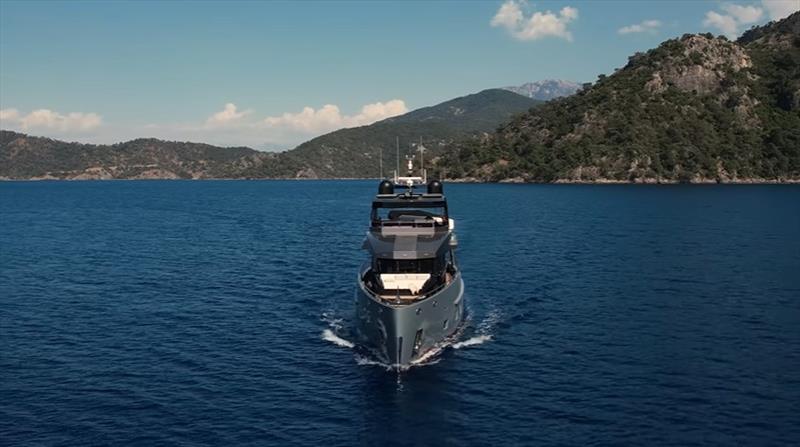
Bering Exclusive: Displacement - Why is displacement one of the key features of an expedition boat?
by Bering Yachts 4 Nov 2022 12:37 GMT

Bering Exclusive: Displacement - Why is displacement one of the key features of an expedition boat? © Bering Yachts
Welcome to Bering Exclusive - a new regular section of our educational videos. It will feature a deep look into the technology and production of Bering yachts. We hope these videos will be helpful in your boat-searching process.
We would like to start with the video on displacement. Why is displacement one of the key features of an expedition boat? Let us hear from Bering in these exclusive video series.
The three types of motor yachts can be distinguished by their displacement and hull type:
Planing yachts
Light, powerful, and speedy vessels. They are designed to ride on top of the water, move quickly, and operate in preferably flat waters. Among their disadvantages are susceptibility to rough weather, reduced stability at planing speeds, and high fuel consumption.
Semi-displacement yachts
A blend of the other two types, they are more comfortable than planing and faster than displacement boats, have smaller draft and are capable of withstanding weather to a certain degree. However, they still need an expensive stabilizer system, fuel economy at higher speeds is far from ideal, and the hull integrity might be compromised when sailing in icy waters.
Displacement yachts
heavy, slow, and stable. They are designed to be comfortable and stable in any weather conditions, have a long range, carry an extensive amount of fuel and other supplies, and are very economical and safe. Displacement boats' negatives include slow speed and deeper draft, which may limit shallow water travel.
Obviously, each type is great for completing some tasks, and lacks necessary qualities for the others. Bering Yachts chose to give its customers safety, comfort, and freedom. This is why we build vessels, displacement yachts, that are seaworthy, safe, and rangy.
Displacement yachts are ideal for extended passages on the open water. Bering naval architects specifically design our boats to offer maximum capacity and displacement. Deep drafts and rounded hulls offer the greatest volume of onboard space, which allows the vessel to bear large amounts of fuel, provides a wealth of storage and living spaces, and enables it to carry all the necessary equipment, even including smaller watercraft. This gives our comfortable and stable boat an unmatched ability for long-range travel, luxurious conditions, significant passenger-carrying capabilities, and an unmatched number of amenities.
Focusing on displacement boats was a very measured and thought-out decision for Bering. We wanted to provide the true deep-blue enthusiasts with a vessel that is stable, but also affordable. This is why we do not make speedy boats or yachts over 250 feet. We let our customers conquer the seas hassle-free and with a peace of mind and a total assurance that this boat will carry you to wherever you want in any weather and sea condition.
What are the mechanics of displacement boats? When submerged in liquid, the boat is exposed to the "Archimedes' Principle," also known as the physical law of buoyancy. This force is equal in magnitude and opposite in direction to the weight acting on the volume of liquid displaced by the vessel. Said another way, when a yacht is at sea, it moves a certain amount of water, which is equal to its weight (don't forget, this weight includes everything, including the ballast, gas and water onboard, etc.). However, the boat does not sink because its weight is still less than the weight of the water it displaces; the hydrostatic pressure under the hull is enough to keep the vessel afloat.
It is important to note that a truly accurate indicator of a boat's weight is the displacement to length ratio. The higher this ratio is, the heavier the boat is. A heavier boat moves more water, has more stability, and, in general, is more structurally sound. The table below shows how the displacement changes on Bering boats in relation to their length.
Continuing on the length and displacement relation, Bering has produced a number of studies regarding this issue. More than 750 vessels available on the market were researched and compared to Bering-produced boats. The results are presented in two graphs.
The first graph represents the Displacement to Length (DLR) ratio for all researched boats. Since this calculation shows how heavy a boat is relative to its overall length, we can conclude that for Bering boats DLR is significantly higher than in most comparable vessels. Therefore, it is more stable at sea and can carry higher loads. The results are presented in two graphs.
The second graph compares the relation between the Displacement to Length ratio and length in meters of all researched boats. As we can see, this ratio generally increases with length. Matching Bering boats' data with other vessels, one can conclude that Bering has significantly higher results in most cases. This means that Bering boats are heavier per each meter of their length; therefore, they have more stability at sea per foot of their length. However, this does not mean that Bering boats take more power to move. Their naval architecture allows displacement vessels to move with less propulsion than their non-displacement counterparts of similar weight.
Other indicators that are important for the displacement discussion are speed to length ratio and A/B (amount of mass above the waterline to amount of mass below the waterline) ratio. The hull shape comes into play as well. We look forward to addressing these topics in future installments. For now, let us reiterate: Bering choses comfort, safety, and freedom for ourselves and our clients. Full displacement boats offer these qualities in a way the other types of boats simply cannot.
To learn more about displacement, please watch our Bering Exclusive video on YouTube: